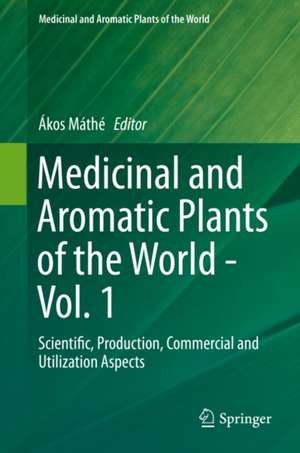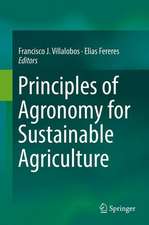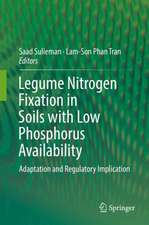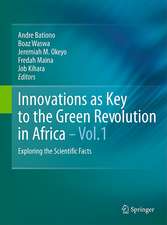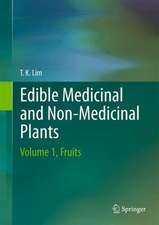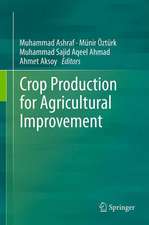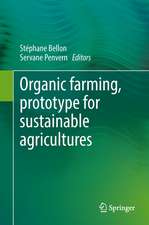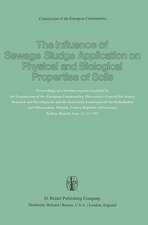Medicinal and Aromatic Plants of the World: Scientific, Production, Commercial and Utilization Aspects: Medicinal and Aromatic Plants of the World, cartea 1
Editat de Ákos Máthéen Limba Engleză Hardback – 9 oct 2015
| Toate formatele și edițiile | Preț | Express |
|---|---|---|
| Paperback (1) | 734.90 lei 6-8 săpt. | |
| SPRINGER NETHERLANDS – 23 aug 2016 | 734.90 lei 6-8 săpt. | |
| Hardback (1) | 1021.05 lei 3-5 săpt. | |
| SPRINGER NETHERLANDS – 9 oct 2015 | 1021.05 lei 3-5 săpt. |
Preț: 1021.05 lei
Preț vechi: 1245.18 lei
-18% Nou
Puncte Express: 1532
Preț estimativ în valută:
195.44€ • 212.36$ • 164.28£
195.44€ • 212.36$ • 164.28£
Carte disponibilă
Livrare economică 31 martie-14 aprilie
Preluare comenzi: 021 569.72.76
Specificații
ISBN-13: 9789401798099
ISBN-10: 9401798095
Pagini: 426
Ilustrații: VIII, 460 p.
Dimensiuni: 155 x 235 x 27 mm
Greutate: 1.05 kg
Ediția:1st ed. 2015
Editura: SPRINGER NETHERLANDS
Colecția Springer
Seria Medicinal and Aromatic Plants of the World
Locul publicării:Dordrecht, Netherlands
ISBN-10: 9401798095
Pagini: 426
Ilustrații: VIII, 460 p.
Dimensiuni: 155 x 235 x 27 mm
Greutate: 1.05 kg
Ediția:1st ed. 2015
Editura: SPRINGER NETHERLANDS
Colecția Springer
Seria Medicinal and Aromatic Plants of the World
Locul publicării:Dordrecht, Netherlands
Public țintă
ResearchCuprins
Chapter 1. Introduction Utilization / Significance of Medicinal and Aromatic Plants.- Chapter 2. Botanical Aspects of Medicinal and aromatic Plants.- Chapter 3. Chemical Diversity of Medicinal Plants.- Chapter 4. Application of spectroscopic methods and hyphenated techniques to the analysis of complex plant extracts.- Chapter 5. Medicinal and aromatic plants (MAP): how do they adapt to the environment?.- Chapter 6. Breeding and germplasm preservation.- Chapter 7. Conservation of Wild Crafted Medicinal and Aromatic Plants and Their Habitats.- Chapter 8. Challenges and decision making in cultivation of medicinal and aromatic plants.- Chapter 9. Cultivation and Breeding of Cannabis sativa L. for Preparation of Standardized Extracts for Medicinal Purposes.- Chapter 10. Sustainable Fertilization in Medicinal and Aromatic Plants.- Chapter 11. Sustainable Weed, Disease And Pest Management In Medicinal And Aromatic Plants.- Chapter 12. Introduction to the precision medicinal plant production.- Chapter 13. Medicinal plants to control diseases and pests.- Chapter 14. Quality Assurance of Medicinal and Aromatic Plants- Good Agricultural & Collection Practices (GAP & GCP).- Chapter 15. In vitro micropropagation of medicinal and aromatic plants.- Chapter 16. Herbal medicinal preparations in different parts of the world.- Chapter 17 Medicinal and Aromatic Plants in Scientific Databases.- Chapter 18. International Trade of Medicinal and Aromatic Plants.- Chapter 19. Medicinal Plants Conservation Strategies for Primary-Healthcare and Livelihood at Local Level: An Examination of Initiatives in South Asia.- Chapter 20. Phytogenic feed additives in animal nutrition.- Chapter 21. Multipurpose Herbs: Hidden Potentials and Dangers in the Garden.
Textul de pe ultima copertă
Medicinal and aromatic plants (MAPs) have accompanied mankind from its very early beginnings. Their utilization has co-evolved with homo sapiens itself. Evolution has brought about a profound increase in our scientific knowledge about these species, so that, to date, they find utilization in many facets of our life (eg. pharmaceutical products, feed- and food additives, cosmetics, etc.). Remarkably today, despite the new renaissance of MAPs usage, ca. 80 % of the world’s population relies upon natural substances of plant origin, with most of these botanicals sourced from the wild state. This huge increase in demand has put an unparalleled large burden on the natural resources of MAPs endangering their existence.
The first volume of the series Medicinal Plants of the World, will briefly summarize the most essential current scientific knowledge about the sustainable sourcing of botanicals from both wild-crafting and cultivation. In these 21 chapters, eminent researchers of the topic will summarize latest scientific knowledge from the versatile and most varied scientific disciplines involved: botany, phytochemistry, plant breeding, biotechnology, agrotechnology, mechanization and economics. Individual chapters will deal with the essentials of phytomedical utilization, as well as utilization in the form of animal feed-additives. The volume concludes with a chapter on the poisonous MAPs in our homes, offices and modern everyday environments.
The aim of this volume is to offer basic scientific information on MAPs. It will also enable readers of subsequent volumes to digest and interpret the other volumes in the series, that will deal with important and characteristic wild-crafted and cultivated MAPs of the different geographic and climatic regions of the world.
Thus, the series is meant to be a storehouse of up-to-date information on our global wealth of medicinal and aromatic plants on the basis of which MAPs will be collected,cultivated, traded and utilized in a sustainable way.
The first volume of the series Medicinal Plants of the World, will briefly summarize the most essential current scientific knowledge about the sustainable sourcing of botanicals from both wild-crafting and cultivation. In these 21 chapters, eminent researchers of the topic will summarize latest scientific knowledge from the versatile and most varied scientific disciplines involved: botany, phytochemistry, plant breeding, biotechnology, agrotechnology, mechanization and economics. Individual chapters will deal with the essentials of phytomedical utilization, as well as utilization in the form of animal feed-additives. The volume concludes with a chapter on the poisonous MAPs in our homes, offices and modern everyday environments.
The aim of this volume is to offer basic scientific information on MAPs. It will also enable readers of subsequent volumes to digest and interpret the other volumes in the series, that will deal with important and characteristic wild-crafted and cultivated MAPs of the different geographic and climatic regions of the world.
Thus, the series is meant to be a storehouse of up-to-date information on our global wealth of medicinal and aromatic plants on the basis of which MAPs will be collected,cultivated, traded and utilized in a sustainable way.
Caracteristici
Introductory volume in the series of Medicinal and Aromatic Plants of the World Scientific information on MAPs Series is a storehouse of up-to-date information on our global wealth of medicinal and aromatic plants Includes supplementary material: sn.pub/extras
